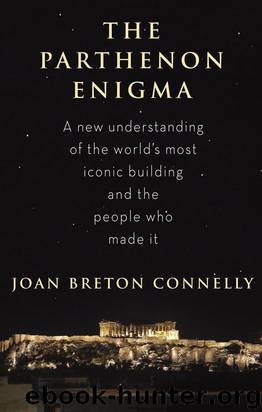The Parthenon Enigma by Joan Breton Connelly

Author:Joan Breton Connelly
Language: eng
Format: mobi, epub
ISBN: 9780385350501
Publisher: Knopf Doubleday Publishing Group
Published: 2014-01-27T22:00:00+00:00
Death of Prokris, showing her “bird-soul” leaving her body while her husband Kephalos and father Erechtheus watch. Column krater, by Hephaistos Painter, ca. 440 B.C. (illustration credit ill.103)
I would say I myself,
a maiden, wail [lelaka] in vain from the sky,
an owl [glaux].
Alkman, First Partheneion 85–87142
Gloria Ferrari points to an important connection between the girls’ chorus that sings this song and the Hyades, the inconsolable nymph sisters who mourn the death of their brother, Hyas, killed in a hunting accident. Known for their weepy raininess, the Hyades become the archetypal singers of dirges, engaged in eternally funereal lament. In the “somber, relentless quality of the night owl’s hooting,” Ferrari hears the “mourning voice” of the Hyades.143 Their grief culminates in their transformation into the star cluster Hyades, a constellation that is further associated with the dead daughters of Erechtheus, catasterized as the Hyakinthides. Some of the final lines preserved in the fragments of Euripides’s Erechtheus give the words “to/for the Hyakinthides,” and “stars.”144
In Athenian vase painting, we find a number of intriguing images that show Athena in the company of three owls. A white-ground lekythos in Kansas bears the image of a helmeted Athena seated within her sanctuary (facing page).145 One owl alights upon her shield, another stands beneath it, and a third perches atop her altar. When the image is read as the souls of the three daughters of Erechtheus, the owl on the altar can be seen as the maiden who was sacrificed (on Athena’s altar) while her sisters, who kept their oath and died as well, are paired together at the left of the scene (as we see them on the Parthenon frieze, set apart from their little sister). The dead heroines are shown on the vase as winged souls, their bodies lost but their spirits living on within the sanctuary of Athena. In this, I build on Ferrari’s interpretation, whereby she associated these owls with the daughters of Kekrops.146 I argue instead that they represent the daughters of Erechtheus, who are, after all, related to and (in the ancient record) often confused with the Kekropids.
A hydria in Uppsala, Sweden, makes the connection even more emphatically. Here, a single owl perches atop an altar within Athena’s shrine, signified by a Doric column (insert this page, top).147 A man leads a ram to sacrifice while a bull stands in readiness at the far right. These represent the same animal victims (sheep and cattle) that are depicted on the north frieze of the Parthenon. Remember Philochoros: “Whoever sacrifices a cow to Athena is obliged to sacrifice a ewe to Pandora.”148 If the owl perched upon the altar represents the sacrificed daughter of Erechtheus, whose name may, in fact, be Pandora, then the ram is an offering for her, while the bull is destined for her father, Erechtheus.
Download
This site does not store any files on its server. We only index and link to content provided by other sites. Please contact the content providers to delete copyright contents if any and email us, we'll remove relevant links or contents immediately.
| Landmarks & Monuments | Religious Buildings |
| Residential |
Kathy Andrews Collection by Kathy Andrews(11726)
The remains of the day by Kazuo Ishiguro(8817)
Paper Towns by Green John(5087)
Spare by Prince Harry The Duke of Sussex(5071)
The Body: A Guide for Occupants by Bill Bryson(4973)
Industrial Automation from Scratch: A hands-on guide to using sensors, actuators, PLCs, HMIs, and SCADA to automate industrial processes by Olushola Akande(4970)
Machine Learning at Scale with H2O by Gregory Keys | David Whiting(4169)
Be in a Treehouse by Pete Nelson(3941)
Never by Ken Follett(3787)
Harry Potter and the Goblet Of Fire by J.K. Rowling(3772)
Goodbye Paradise(3724)
Into Thin Air by Jon Krakauer(3308)
The Remains of the Day by Kazuo Ishiguro(3293)
The Cellar by Natasha Preston(3259)
The Genius of Japanese Carpentry by Azby Brown(3223)
Fairy Tale by Stephen King(3216)
120 Days of Sodom by Marquis de Sade(3177)
Drawing Shortcuts: Developing Quick Drawing Skills Using Today's Technology by Leggitt Jim(2996)
The Man Who Died Twice by Richard Osman(2995)
